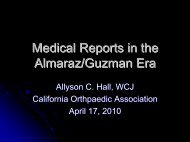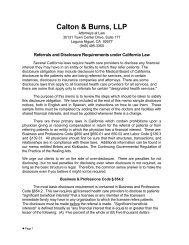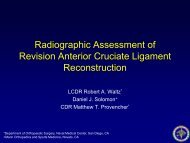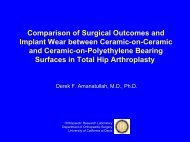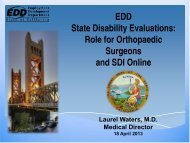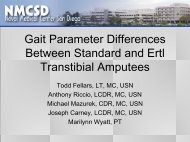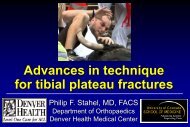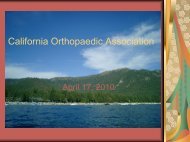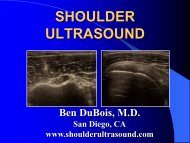Enhancing Your Practice's Revenue - California Orthopaedic ...
Enhancing Your Practice's Revenue - California Orthopaedic ...
Enhancing Your Practice's Revenue - California Orthopaedic ...
- No tags were found...
You also want an ePaper? Increase the reach of your titles
YUMPU automatically turns print PDFs into web optimized ePapers that Google loves.
organization through an activity that lies outside its normalcore activity and purpose.” Given that a significant portionof practice overhead relates to physical plant, equipment,insurance, and so forth, one way of increasing revenue liesin the development of an <strong>Orthopaedic</strong> Urgent Care Center(UCC).Why Pursue this Course of Action?The concept is relatively simple. Setting up a walk-in afterhours or weekend clinic will not only maximize the use ofexisting office space, it will also allow the physician(s) togain access to a population of new patients. In addition toexpanding the practice’s patient catchment and revenue,these clinics provide a convenient alternative for patientsaccessing care. These days, patients’ time is limited, andthey very much appreciate it when they have the optionof visiting their physician when it is convenient for them.Further, it costs far less to receive emergency care (forexample for a sports-related fracture incurred during afterschoolpractice) in an orthopaedist’s office than in the ER.The hours can be tailored to attract specific groups ofpatients that otherwise have trouble visiting the practice;for example, working parents, the elderly and children inschool. The elderly in particular may appreciate the abilityto visit the office on a Saturday, avoiding traffic delays thatoften take place on weekdays. And compared to the ER,patients can be seen much more quickly and efficiently.A UCC has the potential to charge a premium for carethat is delivered after hours especially if it is credentialed/designated. If it is just an extension of your own office,you may or may not be able to accomplish this in theshort term. However, at the time you renew your payercontract(s), be sure to do your utmost to negotiate an additionalbump in the after-hours “fee;” this will make a lotof sense to payers who want to avoid ER charges related towalk-in orthopaedic injuries. Since over 20% of ER casesare typically orthopaedic injuries that are able to be handledin the office, the potential savings to payers (not to mentionthe entire healthcare system) are huge.This chapter is not intended to cover coding specifics.For this you need to seek expert counsel. Following howeverare a few general points to consider:• The 99281-99285 range may or may not be recognizedby payers; therefore, it is important to check with themto be sure your billing is consistent with their paymentpolicies.• Even if the payers will pay, reimbursement for this rangeof codes may be lower than for the 9920X and 9924Xranges based on RVU value.• There used to be a 9905X code for after-hours care.However, Medicare no longer recognizes the code and itis not in the CPT book. Most payers will not reimbursebut some reportedly will. (For more information, seehttp://www.aapc.com/memberarea/forums/showthread.php?t=46750.)• Exercise great care in balance billing the patient if apayer rejects a claim with a 9905X code. Is it beingdenied because it is seen as being “bundled?” Is it deniedbecause it was deemed to be not-covered? When indoubt, consult a coding expert or a payer representative.For more information, AAOS members should feel freeto contact staff in the AAOS Medical Affairs Department.An alternative resource is to check with the Urgent Care Associationof America or UCAOA (http://www.ucaoa.org).As will be discussed below, one option is to set up yourUrgent Care Center as a separate PC. In this situation, itmay be possible to charge fee-for-service out-of-network.To reiterate, coding is key to operating a successful UCC;be sure you know how to code for appropriate reimbursement.Organization StructureUrgent care centers can be setup as an extension of yourexisting practice or a separate PC.• Extension of an existing practice: A key advantage ofsetting up your UCC as an extension of your existingpractice is a reduction in overhead per hour; this isbecause services are being rendered in the facility for alonger period of time. Note, however, that total overheadmay increase because additional staff could be neededto run the center. It may be possible to lessen theimpact of this, though, by staggering current employees’work hours assuming their time is not currently fullyutilized. Another advantage of setting up the UCC as anextension of the existing practice is the investment willbe lower - - everything (or virtually everything) neededto run the center is already in place.• Setting up a separate PC: This model would requiremore investment because (a) you would incur legalexpenses of setting up a new venture and (b) you wouldlikely locate the center elsewhere. However, as statedabove, you would have the advantage of organizingthe PC to be an out-of-network entity and setting upyour own fee schedule. You could become a consultantto this center and receive a salary. You may also beable to develop a venture relationship with other localorthopaedic groups to solidify community acceptanceand make it a mutually beneficial arrangement. Anyjoint venture arrangement with other physicians orhealthcare institutions needs to be set up with care toensure compliance with federal and state Stark and antikickbackregulations.16© 2011 American Academy of <strong>Orthopaedic</strong> Surgeons




